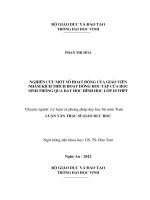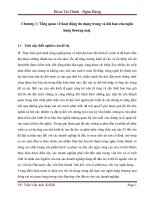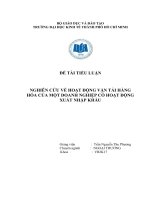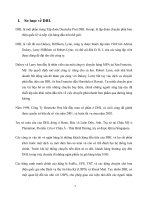NGHIÊN CỨU VỀ HOẠT ĐỘNG CỦA GIÁO VIÊN
Bạn đang xem bản rút gọn của tài liệu. Xem và tải ngay bản đầy đủ của tài liệu tại đây (911.71 KB, 102 trang )
AN INVESTIGATION INTO EFL TEACHER'S ACTIVITIES
OF TEACHING PRONUNCIATION TO GRADE 5 STUDENTS
IN SOME PRIMARY SCHOOLS IN ........ CITY
MA THESIS IN THEORY AND METHODOLOGY
OF ENGLISH LANGUAGE TEACHING
i
AN INVESTIGATION INTO EFL TEACHER'S ACTIVITIES
OF TEACHING PRONUNCIATION TO GRADE 5 STUDENTS
IN SOME PRIMARY SCHOOLS IN ........ CITY
MA THESIS IN THEORY AND METHODOLOGY
OF ENGLISH LANGUAGE TEACHING
i
NGHIÊN CỨU VỀ HOẠT ĐỘNG CỦA GIÁO VIÊN
TRONG VIỆC DẠY PHÁT ÂM DÀNH CHO HỌC SINH
KHỐI 5 Ở MỘT SỐ TRƯỜNG TIỂU HỌC
TẠI THÀNH PHỐ .................
LUẬN VĂN THẠC SĨ LÝ LUẬN VÀ PHƯƠNG PHÁP
DẠY HỌC BỘ MÔN TIẾNG ANH
MÃ SỐ: 60.14.01.11
STATEMENT OF ORIGINALITY
This work has not previously been submitted for a degree or diploma in any
university. To the best of my knowledge and belief, the thesis contains no material
previously published or written by another person except where due reference is made in the
thesis itself.
ABSTRACTS
ACKNOWLEDGEMENT
MINISTRY OF EDUCATION AND TRAINING
HUE UNIVERSITY OF FOREIGN LANGUAGES
*****
TRAN NHU PHUONG
AN INVESTIGATION INTO EFL TEACHER'S ACTIVITIES
OF TEACHING PRONUNCIATION TO GRADE 5 STUDENTS
IN SOME PRIMARY SCHOOLS IN HUE CITY
INVESTIGATION INTO TEACHING ENGLISH PRONUNCIATION
FOR THE 5TH GRADE IN SOME PRIMARY SCHOOLS IN HUE
MA THESIS IN THEORY AND METHODOLOGY
OF ENGLISH LANGUAGE TEACHING
HUE, 2018
MINISTRY OF EDUCATION AND TRAINING
HUE UNIVERSITY OF FOREIGN LANGUAGES
-----------Phuong! Check this out! Why do you still have these highlights unchanged???
This page and the next are a mess!!!
HỌ VÀ TÊN NGƯỜI THỰC HIỆN LUẬN VĂN (Không dấu)
A STUDY ON TEACHING ENGLISH PRONUNCIATION FOR THE
5TH GRADE IN SOME PRIMARY SCHOOLS IN HUE
??? [WHAT IS THIS?]
THEORY AND METHODOLOGY
OF ENGLISH LANGUAGE TEACHING
HUE, 2017???
MINISTRY OF EDUCATION AND TRAINING
HUE UNIVERSITY OF FOREIGN LANGUAGES
------------
HỌ VÀ TÊN NGƯỜI THỰC HIỆN LUẬN VĂN (Không dấu)
A STUDY ON TEACHING ENGLISH PRONUNCIATION FOR THE
5TH GRADE IN SOME PRIMARY SCHOOLS IN HUE
?
THEORY AND METHODOLOGY
OF ENGLISH LANGUAGE TEACHING
CODE: 60.14.01.11
2016 - 2018
SUPERVISOR: TON NU NHU HUONG
HUE, 2017??
7
TABLE OF CONTENTS
STATEMENT OF ORIGINALITY.......................................................................iii
ABSTRACTS..........................................................................................................iv
ACKNOWLEDGEMENT......................................................................................v
ABBREVIATIONS.................................................................................................ix
LIST OF FIGURES.................................................................................................1
LIST OF TABLES...................................................................................................1
CHAPTER 1. INTRODUCTION...........................................................................1
1.1. Rationale............................................................................................................. 1
1.2. Research objectives............................................................................................2
1.3. Research questions..............................................................................................2
1.4. Scope of Research..............................................................................................2
CHAPTER 2. LITERATURE REVIEW...............................................................3
2.1. Review of the theoretical background of English pronunciation........................3
2.1.1. Definitions of pronunciation............................................................................3
2.1.2. Features of pronunciation................................................................................4
( Source: British Council, 2016)................................................................................6
2.1.3. Benefits of having a good pronunciation.........................................................8
2.1.4. Factors affecting the learning of pronunciation................................................9
2.1.5. Teaching and learning pronunciation.............................................................12
2.2. Young learners and their characteristics............................................................17
2.2.1. Definitions of young learners.........................................................................17
2.2.2. Characteristics of young learners...................................................................18
2.2.3. Teaching pronunciation to young learners.....................................................20
2.2.4. Teaching pronunciation to Vietnamese young learners..................................22
2.3. Vietnamese EFL teachers and young learners...................................................23
i
2.4. Review of previous studies...............................................................................24
2.5. Summary........................................................................................................... 28
CHAPTER 3. RESEARCH METHODOLOGY .................................................29
3.1. Research design................................................................................................29
3.2. Research participants........................................................................................30
3.3. Research instruments........................................................................................33
3.3.1. The questionnaire...........................................................................................33
3.3.2. The interview.................................................................................................33
3.3.3. The classroom observation.............................................................................34
3.4. Procedure..........................................................................................................34
3.4.1. Piloted the questionnaire................................................................................34
3.4.2 .Data collection process..................................................................................35
3.4.3. Procedure of data analysis.............................................................................35
3.5. Summary........................................................................................................... 36
CHAPTER 4. FINDINGS AND DISCUSSION...................................................37
4.1. Introduction......................................................................................................37
4.2. The practice of teaching pronunciation.............................................................37
4.2.1. Activities mainly used to enhance student’s pronunciation............................37
4.2.2. Teacher’s guidance for students to practice pronunciation at home...............40
4.2.3. Teacher’s difficulties in teaching English pronunciation to the students........43
4.3. Discussions.......................................................................................................46
4.3.1. Activities used to enhance students’ pronunciation........................................46
4.3.2. Teacher’s guiding activities for home practice..............................................47
4.3.3. Teacher’s difficulties......................................................................................48
4.4. Teachers’ suggestions on improving the teaching of English pronunciation.....49
4.5. Chapter summary..............................................................................................51
CHAPTER 5. CONCLUSION AND IMPLICATIONS......................................52
ii
5.1. Introduction......................................................................................................52
5.2. Summary of key findings..................................................................................52
5.3. Implications of the study...................................................................................53
5.3.1. Implication for teachers.................................................................................53
5.3.2. Implication for students.................................................................................55
5.3.3. Implications for administrators......................................................................55
5.4. Limitation of the study......................................................................................56
5.5. Suggestions for further research.......................................................................56
REFERENCES......................................................................................................58
APPENDICES........................................................................................................63
ACKNOWLEDGEMENT.....................................................................................iv
ABBREVIATIONS..................................................................................................v
LIST OF FIGURES.................................................................................................1
LIST OF TABLES...................................................................................................1
ABSTRACTS...........................................................................................................2
CHAPTER 1. INTRODUCTION...........................................................................3
1.1. Rationale............................................................................................................ 3
1.2. Research objectives...........................................................................................4
1.3. Research questions............................................................................................4
1.4. Scope of Research.............................................................................................4
CHAPTER 2. LITERATURE REVIEW...............................................................5
2.1. Review of the theoretical background of English pronunciation..................5
2.1.1. Definitions of pronunciation.........................................................................5
2.1.2. Features of pronunciation.............................................................................6
2.1.3. Benefits of having a good pronunciation....................................................10
2.1.4. Factors affecting the learning of pronunciation........................................11
iii
2.1.5. Teaching and learning pronunciation.........................................................13
2.2. Young learners and their characteristics.......................................................18
2.2.1. Definitions of young learners......................................................................18
2.2.2. Characteristics of young learners...............................................................19
2.2.3. Teaching pronunciation to young learners.................................................21
2.2.4. Teaching pronunciation to Vietnamese young learners............................23
2.3. Vietnamese EFL teachers and young learners..............................................24
2.4. Review of previous studies.............................................................................24
2.5. Summary.........................................................................................................28
CHAPTER 3. RESEARCH METHODOLOGY .................................................29
3.1. Research design...............................................................................................29
3.2. Research participants.....................................................................................30
3.3. Research instruments.....................................................................................32
3.3.1. The questionnaire........................................................................................32
3.3.2. The interview................................................................................................33
3.3.3. The classroom observation..........................................................................33
3.4. Procedure........................................................................................................34
3.4.1. Piloted the questionnaire.............................................................................34
3.4.2 .Data collection process................................................................................34
3.4.3. Procedure of data analysis..........................................................................35
3.5. Summary.........................................................................................................35
CHAPTER 4. FINDINGS AND DISCUSSION...................................................36
4.1. Introduction....................................................................................................36
4.2. The practice of teaching pronunciation.........................................................36
4.2.1. Activities mainly used to enhance student’s pronunciation......................36
4.2.2. Teacher’s guidance for students to practice pronunciation at home........39
4.2.3. Teacher’s difficulties in teaching English pronunciation to the students.43
iv
4.3. Discussions.......................................................................................................46
4.3.1. Activities used to enhance students’ pronunciation...................................46
4.3.2. Teacher’s guiding activities for home practice..........................................47
4.3.3. Teacher’s difficulties....................................................................................48
4.4. Teachers’ suggestions on improving the teaching of English pronunciation49
4.5. Chapter summary...........................................................................................50
CHAPTER 5. CONCLUSION AND IMPLICATIONS......................................51
5.1. Introduction....................................................................................................51
5.2. Summary of key findings...............................................................................51
5.3. Implications of the study................................................................................52
5.3.1. Implication for teachers..............................................................................52
5.3.2. Implication for students..............................................................................53
5.3.3. Implications for administrators..................................................................54
5.4. Limitation of the study...................................................................................54
5.5. Suggestions for further research....................................................................55
REFERENCES......................................................................................................56
APPENDICES........................................................................................................59
ACKNOWLEDGEMENT.....................................................................................iv
ABBREVIATION....................................................................................................v
LIST OF FIGURES.................................................................................................1
LIST OF TABLE......................................................................................................1
INTRODUCTION...................................................................................................1
CHAPTER 1. INTRODUCTION...........................................................................2
1.1. Rationale............................................................................................................ 2
1.2. Research objectives...........................................................................................3
1.3. Research questions............................................................................................3
1.4. Scope of Research.............................................................................................3
v
CHAPTER 2. LITERATURE REVIEW...............................................................4
2.1. Review of the theoretical background of English pronunciation..................4
2.1.1. Definitions of pronunciation.........................................................................4
2.1.2. Features of pronunciation.............................................................................5
2.1.3. Benefits of having a good pronunciation......................................................9
2.1.4. Factors affecting the learning of pronunciation........................................10
2.1.5. Teaching and learning pronunciation.........................................................12
2.2. Young learners and their characteristics.......................................................17
2.2.1. Definitions of young learners......................................................................17
2.2.2. Characteristics of young learners...............................................................18
2.2.3. Teaching pronunciation to young learners.................................................20
2.2.4. Teaching pronunciation to Vietnamese young learners............................22
2.3. Vietnamese EFL teachers and young learners..............................................23
2.4. Review of previous studies.............................................................................23
2.5. Summary.........................................................................................................27
CHAPTER 3. RESEARCH METHODOLOGY .................................................28
3.1. Research design...............................................................................................28
3.2. Research participants.....................................................................................29
3.3. Research instruments.....................................................................................31
3.3.1. The questionnaire........................................................................................31
3.3.2. The interview................................................................................................32
3.3.3. The classroom observation..........................................................................32
3.4. Procedure........................................................................................................33
3.4.1. Piloted the questionnaire.............................................................................33
3.4.2 .Data collection process................................................................................33
3.4.3. Procedure of data analysis..........................................................................34
3.5. Summary.........................................................................................................34
vi
CHAPTER 4. FINDINGS AND DISCUSSION...................................................35
4.1. Introduction....................................................................................................35
4.2. The practice of teaching pronunciation.........................................................35
4.2.1. Activities mainly used to enhance student’s pronunciation......................35
4.2.2. Teacher’s guidance for students to practice pronunciation at home........38
4.2.3. Teacher’s difficulties in teaching English pronunciation to the student. .42
4.3. Discussions.......................................................................................................45
4.3.1. Activities used to enhance students’ pronunciation...................................45
4.3.2. Teacher’s guiding activities for home practice..........................................46
4.3.3. Teacher’s difficulties....................................................................................47
4.4. Teachers’ suggestions on improving the teaching of English pronunciation48
4.5. Chapter summary...........................................................................................49
CHAPTER 5. CONCLUSION AND IMPLICATIONS......................................50
5.1. Introduction....................................................................................................50
5.2. Summary of key findings...............................................................................50
5.3. Implications of the study................................................................................51
5.3.1. Implication for teachers..............................................................................51
5.3.2. Implication for students..............................................................................52
5.3.3. Implications for administrators..................................................................53
5.4. Limitation of the study...................................................................................53
5.5. Suggestions for further research....................................................................54
LIST OF REFERENCES......................................................................................55
APPENDIX............................................................................................................58
vii
viii
ACKNOWLEDGEMENT
I cannot accomplish this thesis without valuable supports of my supervisor, my
colleagues, friends, family and particularly the fifth-grade students in some Primary Schools
in Hue.
Firstly, I would like to send my grateful expression and sincere thanks to my
supervisor, Dr. Ton Nu Nhu Huong for her invaluable advice. She has been able to offer me
some of his time despite his demanding professional duties.
Secondly, I would love to express my warm thanks to teachers who have been
participating in my research contributed the project’s success. They have further inspired and
provided me a lot of useful results for my thesis.
Thirdly, I want to spend my thanks and gratitude to my friends and family who
supported me a lot during my master course.
ix
ABBREVIATIONS
ELF
English as foreign language
FL
Foreign language
x
LIST OF FIGURES
Figure 2.1: Features of pronunciation........................................................................4
Figure 2.2: English phonemic chart...........................................................................6
( Source: British Council, 2016)................................................................................6
Figure 2.3: Song “Five little ducks” for learning pronunciation..............................17
Figure 3.1.: Age and Gender....................................................................................31
Figure 3.2: Schools and Years of experience...........................................................32
Figure 4.1: The frequency of activities teacher mainly used to enhance student’s
pronunciation...........................................................................................................38
Figure 4.2.: Teacher’s guidance for students to practice pronunciation at home ......41
Figure 4.3.: Teacher’s difficulties in teaching English pronunciation to the students44
xi
LIST OF TABLES
Table 4.1 Descriptive Statistics.............................................................................37
Table 4.2 The frequency of activities mainly used to enhance student’s pronunciation38
Table 4.3 Mean score of questionnaire items in activities...................................40
Table 4.4.Teacher’s guidance for students to practice pronunciation at home. 41
Table 4.5 Mean score of questionnaire items in activities...................................43
Table 4.6 Teacher’s difficulties in teaching English pronunciation to the students
xii
44
LIST OF FIGURES
Figure 2.1: Features of pronunciation.................................................................................6
Figure 2.2: English phonemic chart.....................................................................................7
Figure 2.3: Song “Five little ducks” for learning pronunciation.....................................17
Figure 3.1.: Age and Gender...............................................................................................30
Figure 3.2: Schools and Years of experience.....................................................................30
Figure 4.1: The frequency of activities teacher mainly used to enhance student’s
pronunciation...................................................................................................................... 37
Figure 4.2.: Teacher’s guidance for students to practice pronunciation at home...........40
Figure 4.3.: Teacher’s difficulties in teaching English pronunciation to the students....43
11
LIST OF TABLE
Table 4.1 Descriptive Statistics...........................................................................................36
Table 4.2 The frequency of activities mainly used to enhance student’s pronunciation37
Table 4.3 Mean score of questionnaire items in activities.................................................39
Table 4.4.Teacher’s guidance for students to practice pronunciation at home...............40
Table 4.5 Mean score of questionnaire items in activities.................................................43
Table 4.6 Teacher’s difficulties in teaching English pronunciation to the students........43
11
ABSTRACTSINTRODUCTIONPROBLEM STATEMENT
The main purpose of this research was to identify the English pronunciation
teaching methods of English teachers for the 5th grade students at some primary
schools in Hue. In order to gain the objective of study, firstly, the author finds out the
review of the theoretical background of English pronunciation, including the definition
of pronunciation, features of pronunciation, factors affecting the pronunciation
learning, the definition of young learners and their characteristics. Besides, the author
also discovers some previous studies regarding to the pronunciation teaching of English
teachers.
Moreover, the research questions are related to some issues, including activities
mainly used to enhance student’s pronunciation, teacher’s guidance for students to
practice pronunciation at home, teacher’s difficulties in teaching English pronunciation
to the student. Furthermore, the research was investigated through questionnaire,
interview and class observation instrument. The questionnaire was designed for 30
English teachers at some primary schools in Hue. In addition, through class
observation and interview, the author found out the English pronunciation teaching
methods. From that, the appropriate solutions to improve the pronunciation teaching
skills were recommended. Finally, I hope this research will contribute a small part in
helping teacher improve English pronunciation teaching skill to help student study
English better.
English is an extremely important language in industrialization and
modernization age, particularly in integration period. English is nowadays the main
language for any area at a global level, which is the reason why at schools in countries
English is considered as the second language all around the world, which results in the
priority on English teaching. English is regarded as a key which helps us widen our
knowledge thanks to communicating with international friends, and approaching every
field in life as this language is the common expression for everybody. Vietnam is more
developing that asks us for pursuing changes and common trend of society quickly.
11









